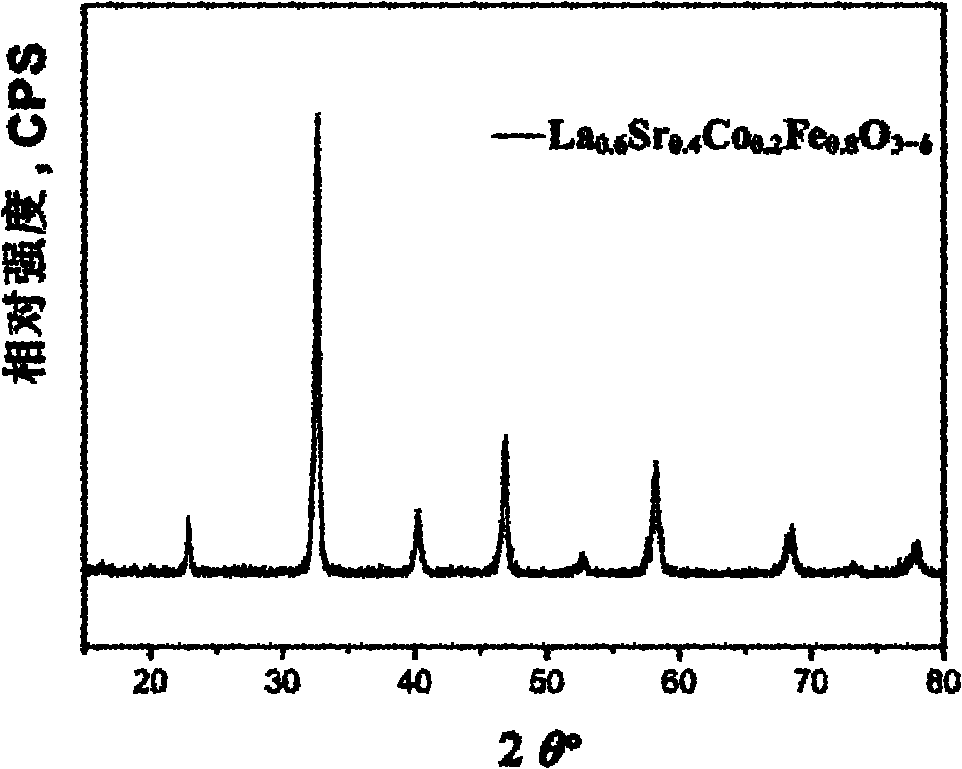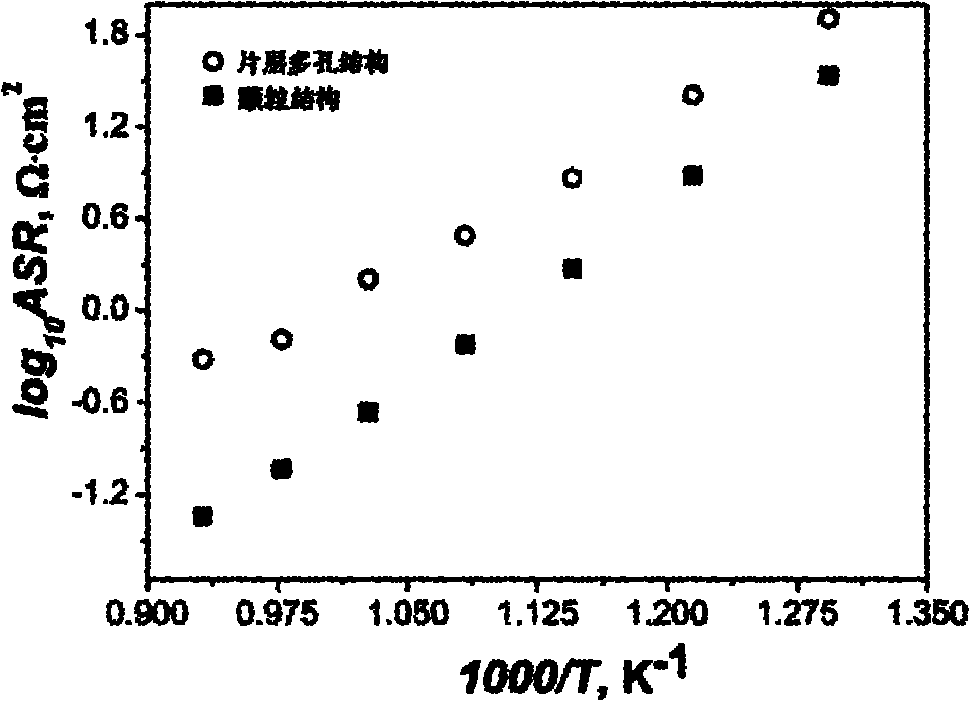Preparation method of cathode of low-medium temperature solid oxide fuel cell
A fuel cell cathode, solid oxide technology, applied in battery electrodes, circuits, electrical components, etc., can solve the problems of high cathode polarization impedance, poor repeatability, slow transmission, etc.
- Summary
- Abstract
- Description
- Claims
- Application Information
AI Technical Summary
Problems solved by technology
Method used
Image
Examples
Embodiment 1
[0028] (1) Synthesis of La 0.6 Sr 0.4 co 0.2 Fe 0.8 o 3-δ Nanopowder: take La(NO 3 ) 3 ·6H 2 O, Sr(NO 3 )2 , Co(NO 3 ) 2 ·6H 2 O, Fe(NO 3 ) 3 9H 2 O was dissolved in deionized water, and then EDTA and citric acid were added according to the ratio of the total number of metal ions: EDTA: citric acid (number of moles) = 1:1:1.2, and then NH 3 ·H 2 O to adjust the pH value of the solution to 6-10. Evaporate and concentrate at 80-90 to obtain a reddish-brown gel. The gel is heated in an air atmosphere at 200-400° C. for 5-8 hours to obtain a precursor. The precursor is calcined in air at 700-1000°C for 2-10 hours to obtain La 0.6 Sr 0.4 co 0.2 Fe 0.8 o 3-δ .
[0029] (2)La 0.6 Sr 0.4 co 0.2 Fe 0.8 o 3-δ Preparation of the cathode layer: the mass ratio of 1 to 5% La 0.6 Sr 0.4 co 0.2 Fe 0.8 o 3-δ The powder is mixed with PVB with a mass ratio of 1-5%, 1-5% PVP, 1-10ml terpineol, 1% graphite powder and ethanol, and ball milled for 2-10 hours to form a ...
Embodiment 2
[0037] (1) Synthesis of Pr 0.6 Sr 0.4 co 0.2 Fe 0.8 o 3-δ Nanopowder: Pr(NO 3 ) 3 ·6H 2 O, Sr(NO 3 ) 2 , Co(NO 3 ) 2 ·6H 2 O, Fe(NO 3 ) 3 9H 2 O was dissolved in deionized water, and then EDTA and citric acid were added according to the ratio of the total number of metal ions: EDTA: citric acid (number of moles) = 1:1:1.2, and then NH 3 ·H 2 O to adjust the pH value of the solution to 6-10. Evaporate and concentrate at 80-90° C. to obtain a reddish-brown gel. The gel is heated in an air atmosphere at 200-400° C. for 5-8 hours to obtain a precursor. The precursor is calcined in air at 700-1000°C for 2-10 hours to obtain Pr 0.6 Sr 0.4 co 0.2 Fe 0.8 o 3-δ .
[0038] (2) Preparation of the cathode layer: the obtained Pr 0.6 Sr 0.4 co 0.2 Fe 0.8 o 3-δ The powder is mixed with 1-5% PVB, 1-5% PVP, 1-10ml terpineol and ethanol, and ball milled for 2-10 hours to form a slurry mixture; heat the GDC electrolyte ceramic sheet on an electric heating plate to 100...
Embodiment 3
[0041] (1) Synthesis of Ga 0.6 Sr 0.4 co 0.2 Fe 0.8 o 3-δ Nanopowder: take Ga(NO 3 ) 3 ·6H 2 O, Sr(NO 3 ) 2 , Co(NO 3 ) 2 ·6H 2 O, Fe(NO 3 ) 3 9H 2 O was dissolved in deionized water, and then EDTA and citric acid were added according to the ratio of the total number of metal ions: EDTA: citric acid (number of moles) = 1:1:1.2, and then NH 3 ·H 2 O to adjust the pH value of the solution to 6-10. Evaporate and concentrate at 80-90° C. to obtain a reddish-brown gel. The gel is heated in an air atmosphere at 200-400° C. for 5-8 hours to obtain a precursor. The precursor is calcined in air at 700-1000°C for 2-10 hours to obtain Ga 0.6 Sr 0.4 co 0.2 Fe 0.8 o 3-δ .
[0042] (2) Ga 0.6 Sr 0.4 co 0.2 Fe 0.8 o 3-δ Cathode layer preparation: Ga 0.6 Sr 0.4 co 0.2 Fe 0.8 o 3-δ The powder is mixed with PVB with a mass ratio of 1-5%, 1-5% PVP, 1-10ml terpineol, 1% graphite powder and ethanol, and ball milled for 2-10 hours to form a slurry mixture; Gadolinium...
PUM
| Property | Measurement | Unit |
|---|---|---|
| thickness | aaaaa | aaaaa |
| porosity | aaaaa | aaaaa |
Abstract
Description
Claims
Application Information
 Login to View More
Login to View More - R&D
- Intellectual Property
- Life Sciences
- Materials
- Tech Scout
- Unparalleled Data Quality
- Higher Quality Content
- 60% Fewer Hallucinations
Browse by: Latest US Patents, China's latest patents, Technical Efficacy Thesaurus, Application Domain, Technology Topic, Popular Technical Reports.
© 2025 PatSnap. All rights reserved.Legal|Privacy policy|Modern Slavery Act Transparency Statement|Sitemap|About US| Contact US: help@patsnap.com



